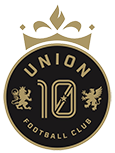
What do position numbers in soccer mean? We break down each soccer position in a typical 11-vs.-11 game and explain its responsibilities.
Think about each position as one part in a well-oiled machine — each part has a specific job to do in order for that machine to function properly. When everyone on the field does their job, the team can work together seamlessly and experience more fluid gameplay.
Soccer positions and formations can vary based on several factors, including age group, league, coaching strategy and number of players allowed on the field. Here, we look at a standard 11-vs.-11 game to show how defensive, midfield and offensive positions work based on the roles they play and the numbers assigned to them.
WHAT’S YOUR NUMBER?
While watching professional soccer, you may hear a commentator declare that an athlete “plays like a number 10” even though they are “playing in the 6.” Don’t worry, there’s no crazy math formula involved — this simply refers to where a player is situated on the field.
Did you know that the numbering of each position started in the 1920s? While not every coach uses this system, knowing position numbers may help inform your understanding of the game. In fact, U.S. Soccer sometimes uses position numbers to help teach youth players about each role and create a universal language as they develop on the pitch.
A number is assigned to each position. When you apply numbers to specific formations, you can better identify where players line up on the field. Here’s how the positions are typically numbered:
1– Goalkeeper
2– Right Fullback
3– Left Fullback
4– Center Back
5– Center Back (or Sweeper, if used)
6– Defending/Holding Midfielder
7– Right Midfielder/Winger
8– Central/Box-to-Box Midfielder
9– Striker
10– Attacking Midfielder/Playmaker
11– Left Midfielder/Wingers
ROLE PLAY
Every position has a different job to do in order to keep the team machine in tip-top shape. For younger players, knowing what’s expected of them is an especially essential component of building their soccer skills. That does not mean, however, that players may only stay in a specific zone or take on a completely limited set of responsibilities. As the individual player and team grows and becomes more skilled, they can get more creative and bring more fluidity to their style of play. Check out these general guidelines for defensive, midfield and offensive positions.
Defensive Soccer Positions
1 – Goalkeeper (GK): Usually the last line of defense to stop the opponent from scoring, this player protects the net. Also known as the keeper or goalie, this is the only player allowed to use their hands and arms to block shots and pick up the ball while the game’s in play. These special rules only apply in the designated penalty area. When a goalie steps outside their penalty box, they must function like a regular field player. Also, they cannot use their hands to play the ball if a teammate passes it directly to them during gameplay or off a throw-in.
Soccer goalies wear specialized soccer goalie gear, including gloves, and often opt for long sleeves for additional protection. They wear a different color jersey than the rest of the team, so everyone on the field can tell them apart from other positions (youth teams may use a pinnie to designate the goalie). They can also wear shorts and pants made specifically for the position.
Defenders/Backs: These are the field players closest to the net. They are responsible for protecting the goalie, blocking shots and stopping the other team’s offensive players from passing, receiving, shooting and scoring. More specifically, there can be center backs, fullbacks, wingbacks and one sweeper.
- 4/5 – Center Back (CB): Also known as the central defender, center fullback or stopper, this position plays in the middle of the rear defensive line. A 4–4–2 formation will have two center backs, which will hang back to protect the goal.
- 3/2 – Fullback (LB, RB): These are the rear defenders on the left and right sides of the field, also referred to as outside fullbacks. They usually play wide to protect the sides of the field, but they can also assist with protecting the center as needed. These players will often move up and down the field to help with offensive plays.
- 3/2 – Wingback (LWB, RWB): This position defends like other defensive backs but is a more offensive position, like a winger. They play wide left and right, running up and down the field. This position requires a lot of stamina and can be more physically demanding than other positions.
- 5 – Sweeper (SW): This position isn’t as common nowadays. When used, this player positions themselves between the goalie and the main defensive line. Their job is to sweep up any balls that get past the defensive backs. While they typically stay behind the other defenders, they can also help take the ball up the field in an offensive push.
Midfield Soccer Positions
As you could probably guess, midfielders, or halfbacks, play mostly in the middle of the field. If the team’s working as a well-oiled machine, midfielders are the gears that connect the defensive and offensive lines, transitioning the ball and making sure everything is moving smoothly. Mids usually see the most action during a game.
- 4 or 6 – Defensive Midfielder (DM): Also known as a holding midfielder, they play directly in front of the defenders. They are responsible for keeping the ball outside of their zone, intercepting the other team’s passes, getting the ball away from the opponent and helping their offensive line by keeping the ball in the other team’s zone, managing rebounds and passing forward. In a 3-4-3 formation, the 4 will flank the 6 as the two holding mids.
- 8 – Central Midfielder (CM): Often considered the most hardworking role, this player has to be ready for action and can play both defensively and offensively, depending on where the ball is. They are responsible for distributing the ball to other players, so it’s vital that they have exceptional ball handling and passing skills. When on the attack, they often take long shots on goal to help the offense. To fit a team’s strategy, they will sometimes line up with the 6 in a more defensive position or with the 10 in a more offensive formation.
- 10 – Attacking Midfielder (AM): The attacking midfielder sits between the midfield and the offensive line. They must know how to score goals and dribble well to avoid the opponent’s defenders. They should attack the ball when the other team is in possession and not hang back like other positions on the field. This position is often seen as the conductor in offensive plays, directing the ball and creating scoring opportunities. They are the playmakers.
- 11/7 – Left/Right Midfielder (LM, RM): Also known as wingers or outside midfielders, these players will stay wide, helping pull the opponent’s defense to the outside to create space for their offensive line. They should have strong 1-vs.-1 skills as they’ll have to get around the other team’s left and right fullbacks and/or wingbacks. These players most likely won’t have the ball much during a game but will instead look for ways to transition the ball forward via cross passes to offensive teammates or by taking shots on goal themselves. They must hustle and have plenty of stamina to keep up with gameplay. Due to their role on the field, wingers are sometimes grouped into offensive or forward positions.
Offensive Soccer Positions
Forwards, or strikers, are the primary attackers and play closest to the opponent’s goal. Their main objective is to score as often as possible. They are usually the quickest on the field and must have exceptional ball control. They should be able to take a shot from all angles, even directly off a pass. It’s also important that any offensive player avoids being offside at any time.
- 9 – Center Forward (CF): Center forwards and strikers can often be synonymous. They must focus on scoring, whether this means dribbling past opponents when they have the ball or ensuring they stay open for a pass when they don’t. Being able to head the ball accurately can really come in handy here.
- 9 – Striker (S): This player positions themselves nearest to the other team’s goal, in front of the center forward. A striker’s primary role is to score. Their teammates will try to pass to them often and there is constant pressure from the other team’s defense, so they should be fast enough to outrun defenders and possess quick footwork and precise ball handling to be most effective. When the other team’s defense is in possession of the ball, strikers should apply pressure to increase the defender’s chances of making a mistake.
- 10 – Second Striker (SS): When used, they sit right behind the center forward and are mainly responsible for setting up scoring opportunities for other attackers. They should be able to shield the ball from the other team and hold them off while waiting for their teammates to position themselves for a good shot. As with any offensive position, second strikers should shoot on goal when they have the chance and possess good ball skills. Heading can also be very important in this position.
GET IN FORMATION
The variety of formations is only limited by the number of players allowed on the pitch, so don’t be surprised to see a range of setups and strategies employed. The overarching responsibilities for each position on the field stay the same, but it is the ability to flow as a unit and show creativity that truly makes soccer a beautiful game.
There are defensive and offensive formations, and any given formation may be more or less successful, depending on the other team’s setup. You’ll notice that the number of players in a formation only adds up to 10. That’s because the formations only relate to field players and exclude the goalie.
Typically, these field players are broken out into three key zones, with the formation being set up from back to front (defense to midfield to forward). That means a 4-4-2 formation has four defensive players, four midfielders and two forwards.
Sometimes coaches will divide the three main sections further, causing formations such as a 1-4-3-2, with one sweeper, four defensive players, three mids and two forwards; or a 4-4-1-1, which has four defenders, four mids, one second striker and one striker.
SOCCER FORMATION EXAMPLES
U.S. Soccer tends to favor a 4-3-3 formation. Two common variations of the 4-3-3 formation are a defensive setup and an attack-minded setup, based on where the 8 lines up. Generally, the 8 is a box-to-box player, so this can rotate continually through the game to react to the run of play.
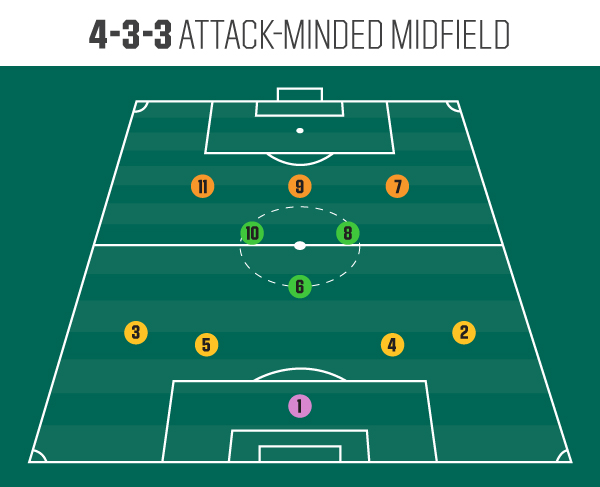
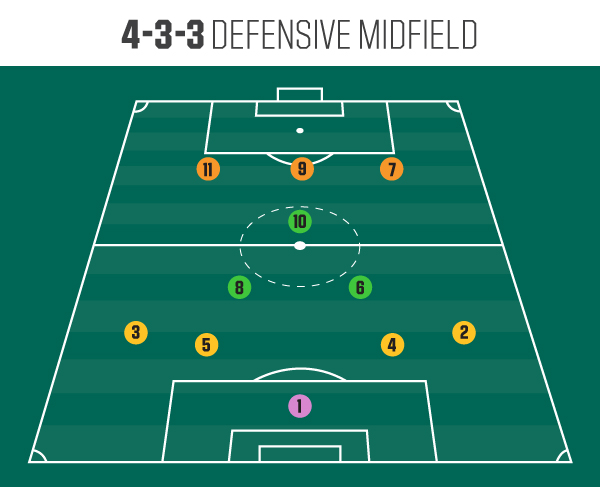
Another popular formation in soccer is the 4-4-2. This is commonly run with a diamond shape in the midfield but can also feature a flat midfield.
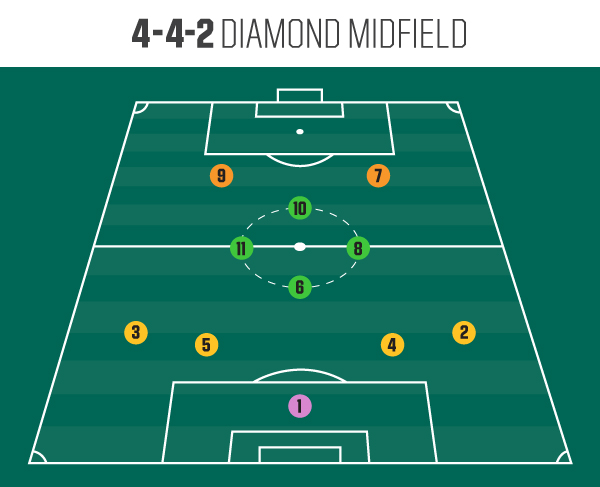
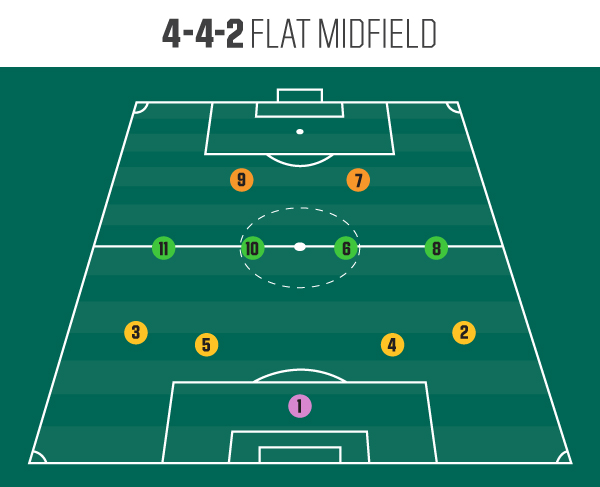
Keep in mind that these are just some common formations and there are several you may see or use in the game. Every coach has a different style and there are multiple ways they could choose to set up formations.
PREPARE FOR THE PITCH
A well-placed header isn’t the only way to get your head in the game. When you know the key responsibilities of each position and how numbers and formations factor in, you can start applying strategy to your gameplay. You’ll notice what works and what doesn’t, so you can adjust the way you play and make game-changing decisions that can help you and your team become more effective.
At the end of the day, don’t overthink it. Your understanding of the game will naturally improve over time. For now, get on the field, practice often and enjoy
